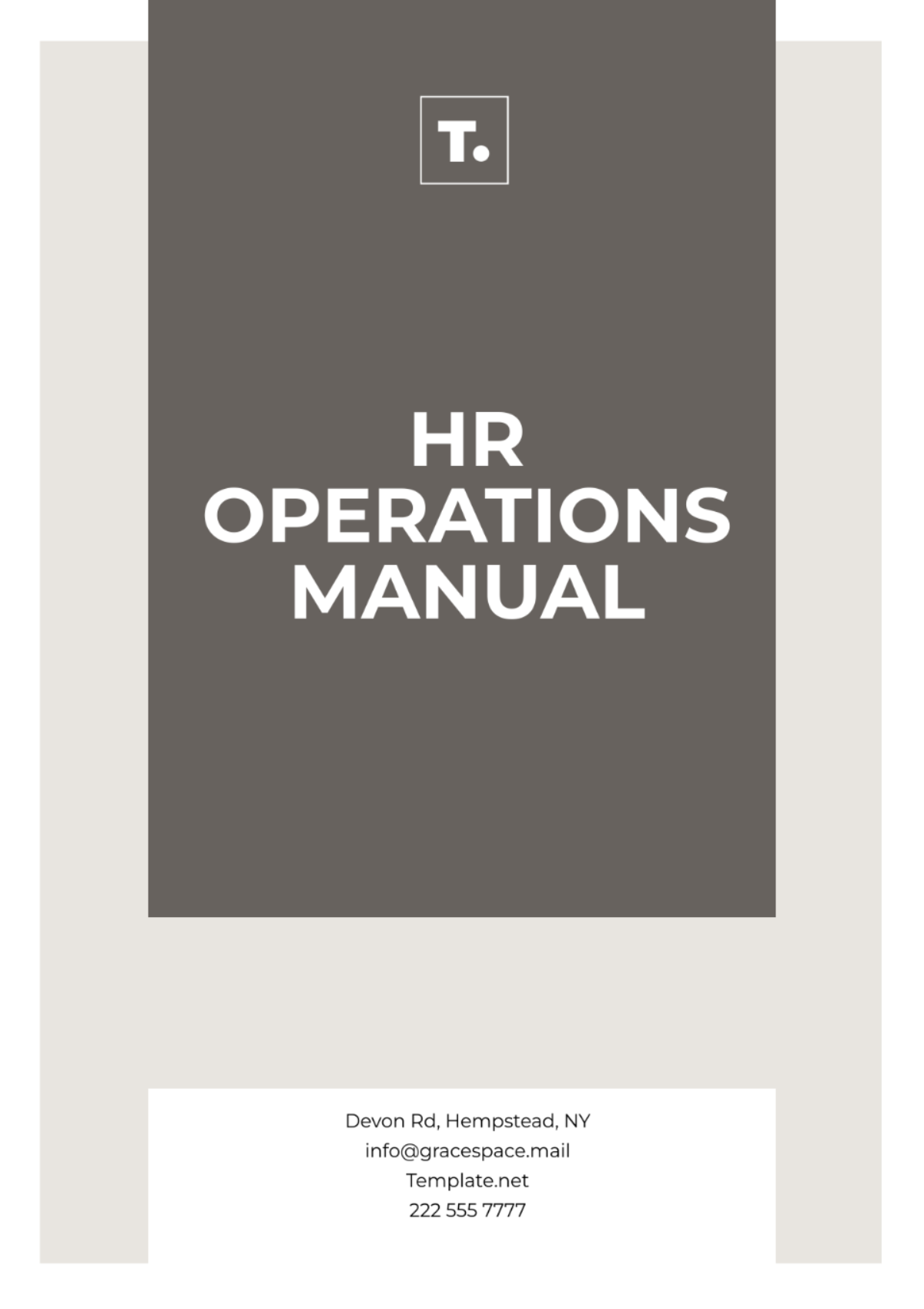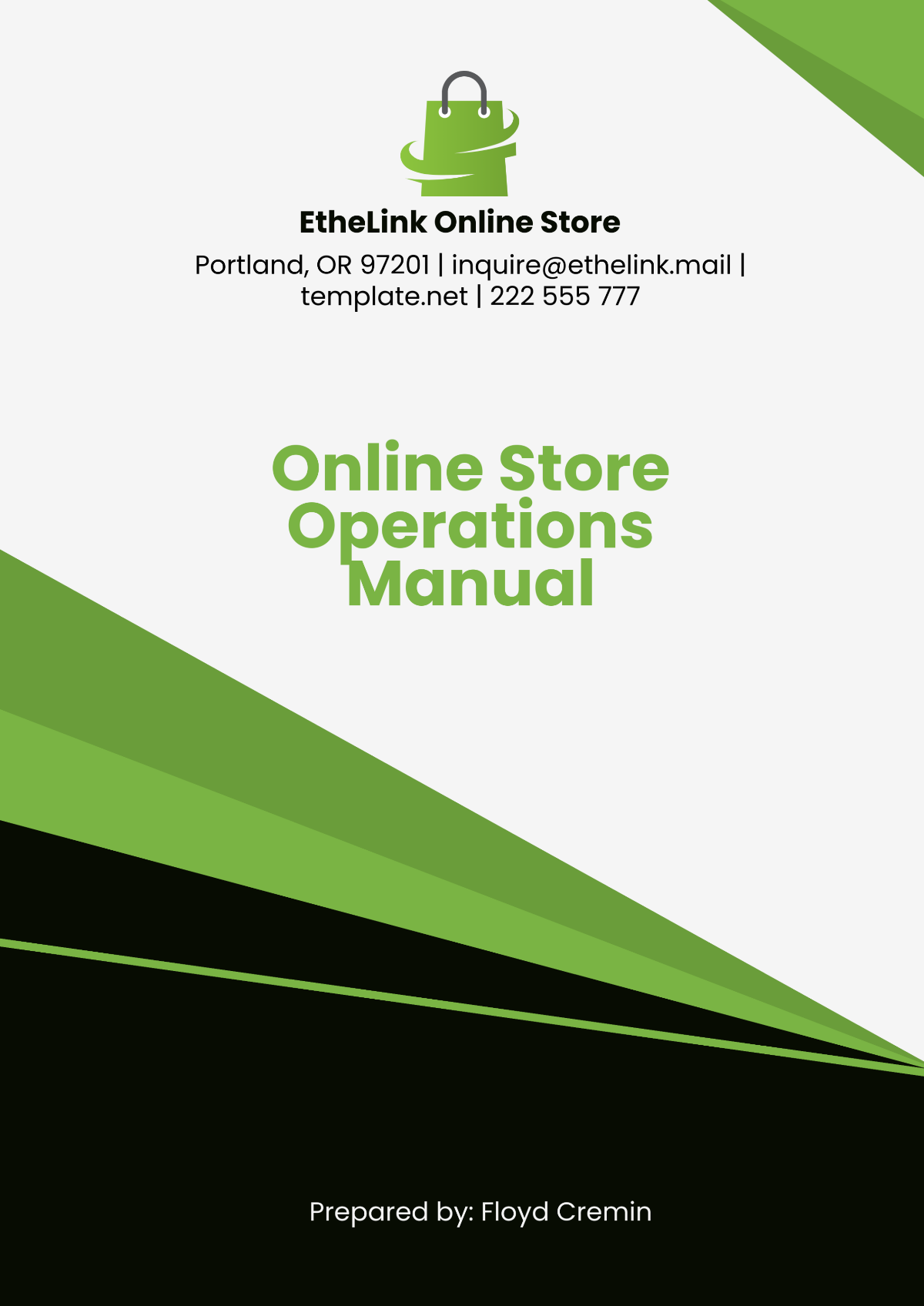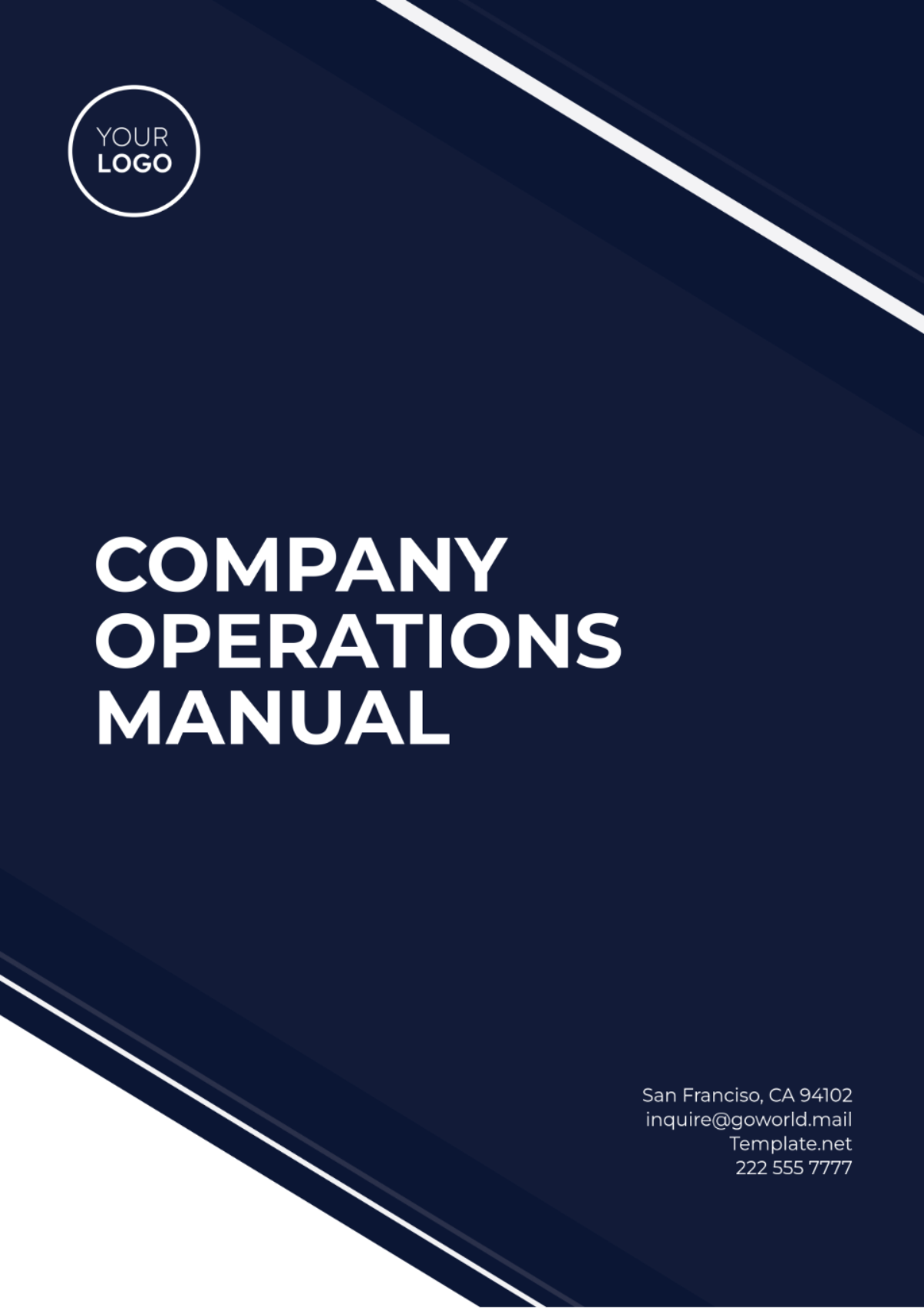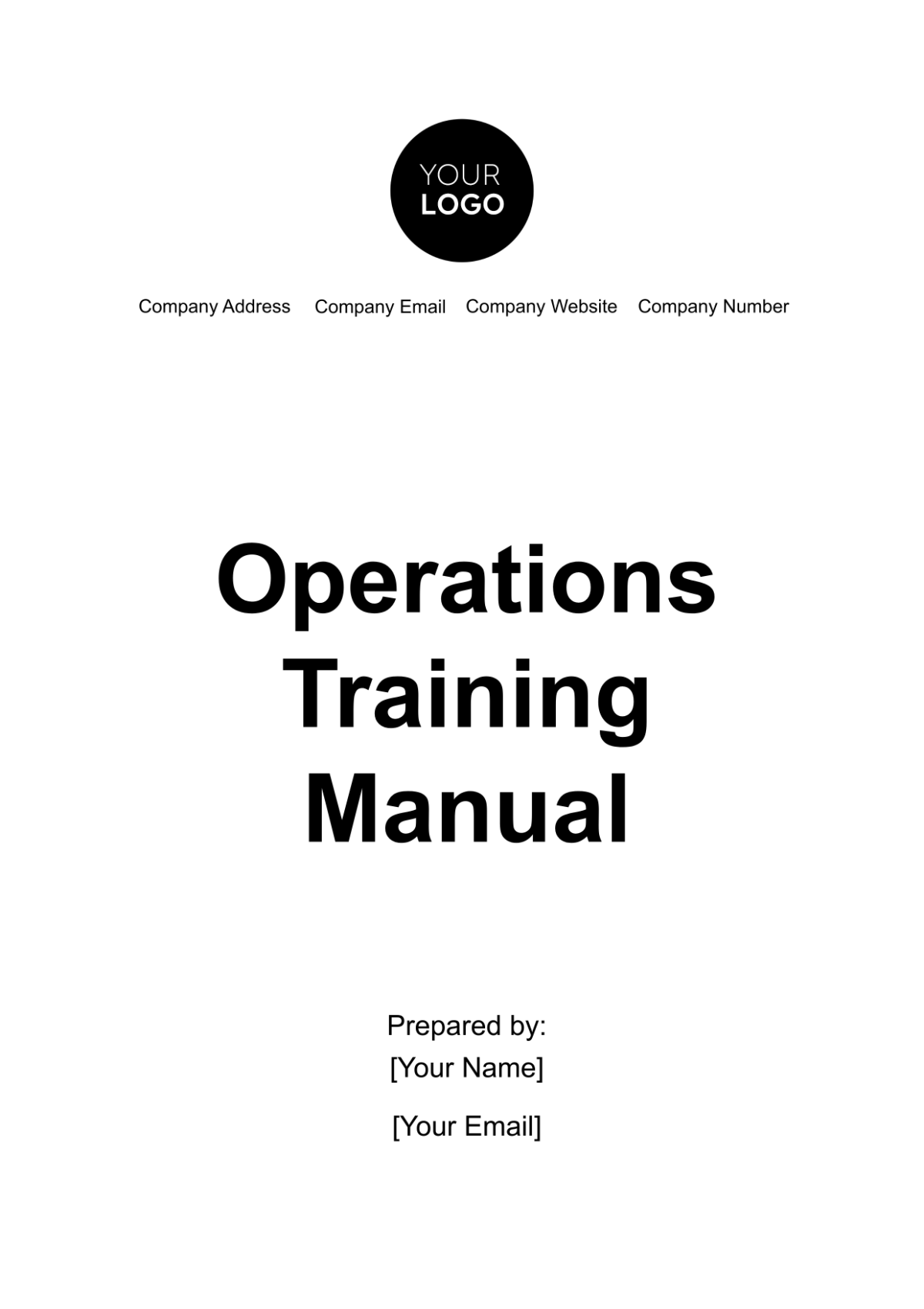Agriculture Operations Manual
I. Introduction
A. Purpose of the Manual
The purpose of this Agriculture Operations Manual is to provide detailed guidelines and procedures to ensure efficient and sustainable farming practices at [Your Company Name]. This manual serves as a comprehensive resource for all employees, stakeholders, and partners involved in the agricultural operations. It aims to standardize practices, enhance productivity, and promote environmental stewardship. By adhering to the protocols outlined in this manual, [Your Company Name] can achieve higher yields, better quality produce, and maintain a competitive edge in the market.
B. Scope
This manual covers all aspects of agricultural operations at [Your Company Name], including crop production, livestock management, equipment maintenance, safety protocols, and environmental conservation. It is designed to be used by farm managers, field workers, technical staff, and administrative personnel. The manual encompasses both day-to-day operations and long-term planning, ensuring that all activities are aligned with the company’s mission and goals. Additionally, it provides guidelines for compliance with relevant regulations and industry standards, ensuring that [Your Company Name] operates responsibly and ethically.
C. Objectives
To ensure consistent and efficient farming practices across all operations, minimizing variability and improving overall performance.
To promote sustainable agriculture and environmental conservation, reducing the ecological footprint of farming activities.
To improve productivity and profitability of farming operations through the adoption of best practices and innovative techniques.
To ensure the safety and well-being of all employees by providing a safe working environment and comprehensive training.
II. Organizational Structure
A. Management Team
Farm Manager: Oversees all farming operations, makes strategic decisions, and ensures compliance with regulations. The Farm Manager is responsible for setting goals, planning budgets, and coordinating with other departments.
Assistant Farm Manager: Assists the Farm Manager in daily operations and supervision. The Assistant Farm Manager handles scheduling, resource allocation, and operational troubleshooting.
Technical Supervisor: Responsible for technical aspects of farming, including irrigation, pest control, and crop rotation. The Technical Supervisor ensures the implementation of scientific and technical advancements.
Administrative Manager: Manages financial records, procurement, and administrative tasks. The Administrative Manager ensures efficient office operations and supports the field teams with logistical needs.
B. Field Workers
Field Supervisors: Lead field workers, manage daily tasks, and ensure adherence to schedules. Field Supervisors are critical in maintaining discipline, quality control, and operational efficiency.
Harvesting Crew: Responsible for harvesting crops at the right maturity and ensuring minimal damage. The Harvesting Crew is trained in using harvesting equipment and techniques to maximize yield and quality.
Planting Crew: Manages planting operations, including seed selection and planting techniques. The Planting Crew ensures proper spacing, depth, and coverage for optimal crop growth.
Maintenance Crew: Maintains equipment, machinery, and infrastructure. The Maintenance Crew conducts regular inspections, repairs, and upgrades to ensure the smooth functioning of all assets.
III. Crop Production
A. Planning and Preparation
1. Land Assessment
Before planting, conduct a thorough assessment of the land to determine soil type, fertility, and suitability for different crops. Soil testing should be done at least once a year to monitor nutrient levels and pH. This includes testing for essential nutrients like nitrogen, phosphorus, and potassium, as well as trace elements. Understanding soil structure and drainage patterns is also crucial for planning irrigation and cultivation practices.
2. Crop Selection
Select crops based on soil type, climate, market demand, and crop rotation plans. Common crops grown at [Your Company Name] include:
Corn: Optimal for loamy soils with a pH of 6.0-6.8. Corn is a high-yield crop with significant market demand.
Wheat: Suitable for well-drained clay loam soils with a pH of 6.0-7.0. Wheat is a staple crop with various varieties suited to different climatic conditions.
Soybeans: Prefer fertile, well-drained soils with a pH of 6.0-7.0. Soybeans are valuable for their oil and protein content.
Consider crop rotation to prevent soil depletion and pest buildup. For instance, rotating legumes like soybeans with cereals like corn can improve soil fertility due to nitrogen fixation by legumes.
3. Seed Procurement
Procure high-quality seeds from reputable suppliers. Ensure seeds are certified and treated to prevent disease and pest infestations. Check for genetic traits such as drought tolerance, pest resistance, and high yield potential. Store seeds in a cool, dry place to maintain their viability until planting.
B. Planting
1. Seedbed Preparation
Prepare the seedbed by plowing, harrowing, and leveling the field. Ensure the soil is loose and free of weeds. This process improves soil aeration, enhances water infiltration, and creates an optimal environment for seed germination and root development.
2. Planting Techniques
Use appropriate planting techniques for each crop. For example:
Corn: Plant seeds 1.5-2 inches deep and 6-8 inches apart in rows. Ensure uniform planting depth and spacing to promote even growth and facilitate mechanical harvesting.
Wheat: Broadcast seeds evenly and cover lightly with soil using a harrow or rake. This ensures good soil-to-seed contact and adequate coverage to protect seeds from birds and environmental factors.
Soybeans: Plant seeds 1-1.5 inches deep and 3 inches apart in rows. Proper spacing helps in canopy formation, which suppresses weeds and optimizes photosynthesis.
C. Crop Management
1. Irrigation
Implement efficient irrigation systems such as drip or sprinkler irrigation to ensure optimal water usage. Monitor soil moisture levels regularly using tensiometers or soil moisture sensors and adjust irrigation schedules accordingly to prevent over- or under-watering.
2. Fertilization
Apply fertilizers based on soil test results and crop requirements. Use organic fertilizers like compost and manure to improve soil fertility and structure. Supplement with synthetic fertilizers as needed to ensure balanced nutrition. Follow recommended application rates and timings to maximize nutrient uptake and minimize environmental impact.
3. Pest and Disease Control
Implement integrated pest management (IPM) strategies, including crop rotation, biological control, and the use of resistant varieties. Regularly scout fields for signs of pests and diseases and take timely action. Use chemical pesticides as a last resort and follow safe handling and application procedures.
D. Harvesting
1. Harvest Timing
Harvest crops at the right maturity to ensure maximum yield and quality. For example:
Corn: Harvest when kernels are fully mature and moisture content is 20-25%. Delayed harvesting can lead to field losses due to pests and weather.
Wheat: Harvest when grains are hard and moisture content is below 15%. Early harvesting can result in immature grains, while late harvesting increases shattering losses.
Soybeans: Harvest when pods are brown and moisture content is 13-15%. Proper timing prevents shattering and ensures optimal seed quality.
2. Harvesting Methods
Use appropriate harvesting equipment to minimize damage and losses. Ensure all equipment is well-maintained and operated by trained personnel. For example, combine harvesters should be adjusted for crop height and density to maximize efficiency and reduce grain loss.
E. Post-Harvest Management
1. Drying
Dry harvested crops to the recommended moisture content to prevent spoilage. Use mechanical dryers or natural drying methods depending on the crop and available resources. Monitor drying conditions to ensure uniform drying and prevent overheating, which can damage the grain.
2. Storage
Store crops in clean, dry, and well-ventilated facilities. Monitor storage conditions regularly to prevent infestations and spoilage. Use pest control measures such as fumigation and maintain proper hygiene to ensure long-term storage quality.
IV. Livestock Management
A. Animal Housing
Provide adequate housing for livestock to ensure their health and well-being. Housing should be well-ventilated, clean, and spacious enough to allow free movement. Proper housing reduces stress, prevents diseases, and improves overall productivity.
B. Feeding and Nutrition
Develop balanced feeding plans based on the nutritional needs of each animal species. Provide clean water and high-quality feed at all times. Adjust feeding plans based on the age, weight, and production stage of the animals to ensure optimal growth and productivity.
C. Health Management
Implement regular health checks and vaccination programs. Monitor animals for signs of illness and provide timely treatment. Maintain detailed health records for each animal to track medical history and treatment outcomes.
D. Breeding
Maintain detailed breeding records to track the genetic quality and performance of livestock. Implement selective breeding practices to improve herd productivity. Use artificial insemination or natural breeding methods depending on the species and breeding goals.
V. Equipment and Machinery
A. Maintenance Schedule
Develop a maintenance schedule for all equipment and machinery. Regular maintenance ensures optimal performance and reduces the risk of breakdowns. Schedule maintenance tasks based on manufacturer recommendations and operational usage.
Equipment | Maintenance Frequency | Tasks |
|---|---|---|
Tractors | Monthly | Oil change, filter replacement, inspection |
Irrigation pumps | Quarterly | Cleaning, lubrication, inspection |
Harvesters | Annually | Overhaul, blade sharpening, inspection |
B. Safety Protocols
Ensure all equipment operators are trained and certified. Provide personal protective equipment (PPE) and enforce safety protocols to prevent accidents. Conduct regular safety drills and inspections to identify and mitigate potential hazards.
VI. Environmental Conservation
A. Sustainable Practices
1. Crop Rotation
Implement crop rotation to improve soil health and reduce pest and disease buildup. Rotate crops based on their nutrient requirements and pest cycles. For example, rotating nitrogen-fixing legumes with nutrient-demanding cereals can enhance soil fertility and reduce the reliance on synthetic fertilizers. This practice also helps break pest cycles, as different crops attract different pests. At [Your Company Name], crop rotation is carefully planned to optimize yields while maintaining soil health over the long term.
2. Conservation Tillage
Adopt conservation tillage practices to reduce soil erosion and improve soil structure. Minimum tillage or no-till methods minimize soil disturbance, preserving organic matter and soil moisture. These practices not only conserve soil but also reduce fuel consumption and greenhouse gas emissions associated with conventional tillage. By implementing conservation tillage, [Your Company Name] contributes to sustainable agriculture practices and enhances overall environmental stewardship.
B. Waste Management
Develop a waste management plan to handle agricultural waste responsibly. Recycle organic waste into compost to enrich soil fertility and reduce the need for chemical fertilizers. Properly dispose of non-organic waste materials such as plastic mulches and pesticide containers according to local regulations. By managing waste effectively, [Your Company Name] minimizes environmental impact and promotes a cleaner agricultural ecosystem.
C. Water Conservation
Implement water conservation measures to optimize water usage and protect water resources. Strategies may include rainwater harvesting, using efficient irrigation systems, and monitoring water application rates. By improving irrigation efficiency and reducing water wastage, [Your Company Name] ensures sustainable water use while maintaining crop productivity.
VII. Safety and Compliance
A. Workplace Safety
1. Safety Training
Provide regular safety training for all employees to promote awareness and safe practices. Training should cover equipment operation, chemical handling, emergency response procedures, and personal protective equipment (PPE) usage. Conduct refresher courses and skill assessments to ensure that employees are competent and prepared to handle workplace hazards effectively.
2. Personal Protective Equipment (PPE)
Ensure all employees have access to appropriate PPE for their tasks. This includes gloves, safety goggles, helmets, and protective clothing as needed. PPE should be inspected regularly for wear and tear, and replacements should be provided promptly. Encourage a culture of safety where wearing PPE is non-negotiable to prevent injuries and ensure a safe working environment.
B. Regulatory Compliance
1. Environmental Regulations
Ensure compliance with all environmental regulations governing agricultural operations. This includes waste management practices, water usage permits, pesticide application guidelines, and soil conservation measures. Regularly review regulatory updates and adjust practices as necessary to maintain compliance and uphold environmental standards.
2. Labor Laws
Comply with local and national labor laws to ensure fair treatment of employees and legal protection for both workers and the company. This includes minimum wage requirements, working hours, overtime pay, and employee benefits. Maintain accurate records of employment, including payroll records, to demonstrate compliance during audits and inspections.
VIII. Record Keeping
A. Financial Records
Maintain detailed financial records of all agricultural operations to track income, expenses, and profitability. Use accounting software or spreadsheets to record transactions, invoices, and financial statements. Analyze financial data regularly to assess the financial health of the farm and make informed decisions regarding budgeting and investments.
B. Production Records
Keep accurate records of crop yields, livestock production, and equipment usage throughout the year. Document planting dates, harvest yields, input applications (fertilizers, pesticides), and any adverse weather events that may impact production. Analyze production data to identify trends, evaluate performance, and optimize future farming strategies.
C. Compliance Records
Maintain records of all compliance-related activities, including safety training sessions, equipment inspections, and regulatory permits. Organize records in a systematic manner for easy retrieval and review during audits or inspections by regulatory agencies. Ensure that all documentation is up to date and accessible to authorized personnel as needed.
IX. Continuous Improvement
A. Training and Development
Invest in ongoing training and development opportunities for employees at all levels. Offer workshops, seminars, and online courses to enhance technical skills, leadership abilities, and knowledge of industry best practices. Encourage employees to pursue certifications or advanced degrees related to agriculture and provide support for professional growth.
B. Research and Innovation
Promote a culture of innovation and research within [Your Company Name]. Collaborate with agricultural researchers, universities, and industry partners to explore new technologies, crop varieties, and farming techniques. Conduct on-farm trials and experiments to evaluate the feasibility and effectiveness of innovative practices before scaling up implementation.
C. Performance Evaluation
Regularly evaluate the performance of agricultural operations using key performance indicators (KPIs) such as yield per acre, input efficiency, labor productivity, and environmental impact. Compare actual performance against set targets and benchmarks to identify areas for improvement and implement corrective actions. Use data-driven insights to make informed decisions and continuously strive for operational excellence.
X. Appendices
A. Crop Yield Data
Crop | Area (acres) | Yield (tons) | Average Yield per Acre (tons) |
|---|---|---|---|
Corn | 100 | 300 | 3.0 |
Wheat | 150 | 450 | 3.0 |
Soybeans | 120 | 360 | 3.0 |
B. Livestock Production Data
Animal | Number of Heads | Annual Production (tons) |
|---|---|---|
Cattle | 50 | 25 |
Poultry | 200 | 10 |
Sheep | 100 | 5 |
C. Equipment Maintenance Data
Equipment | Last Maintenance Date | Next Maintenance Due |
|---|---|---|
Tractors | 01-Jan-2050 | 01-Feb-2050 |
Irrigation | 01-Mar-2050 | 01-Jun-2050 |
Harvesters | 01-Jul-2050 | 01-Dec-2050 |

















































